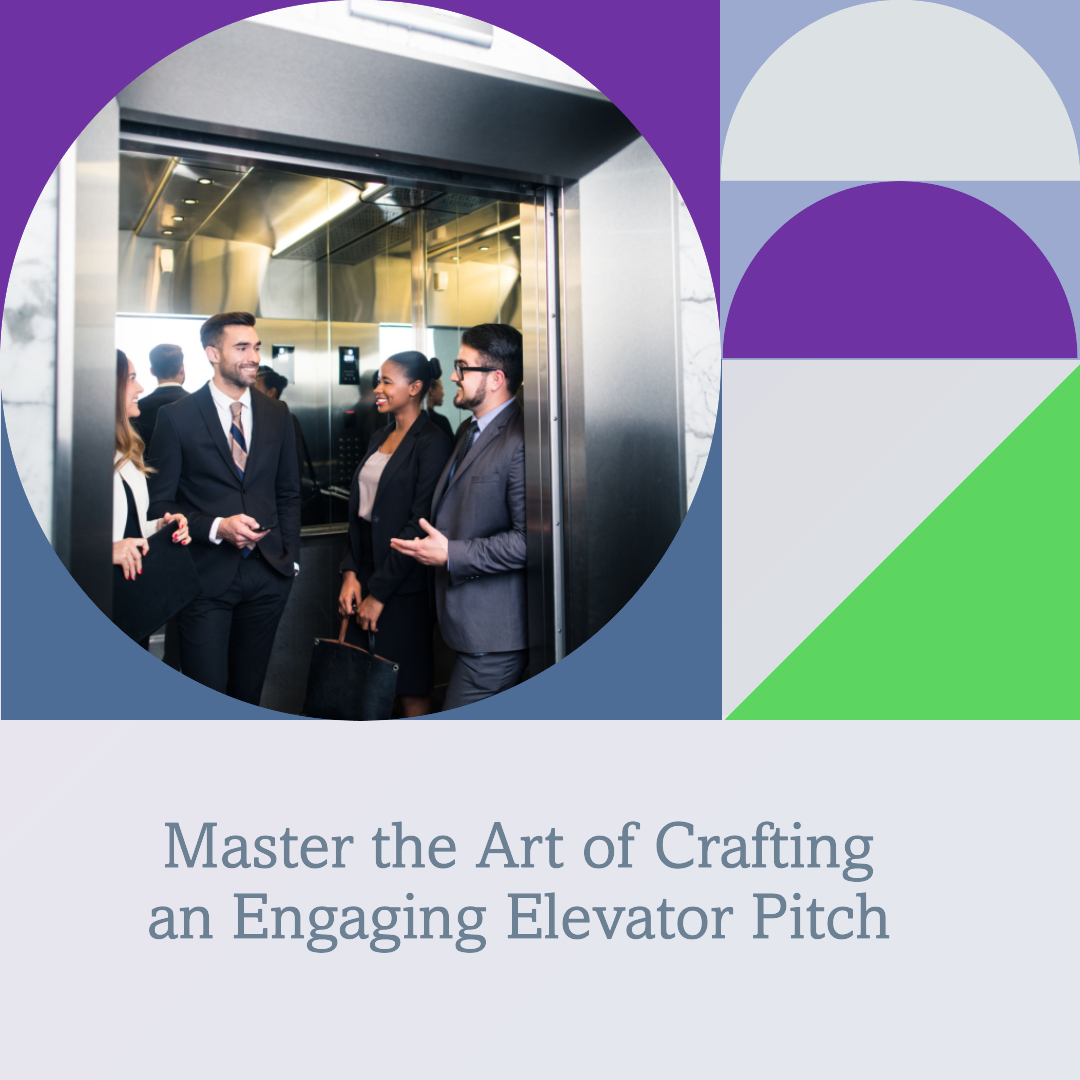10 Tips On How To Craft Elevator Pitch For Maximum Impact
Creating a strong elevator pitch is essential for any business owner. It's a concise and compelling way to share your business idea and capture the interest of potential investors or clients. Follow these 10 tips to create an effective and impactful elevator pitch.

When it comes to getting people interested in what you or your organization does, few tools are as effective as an elevator pitch.
It got its name because of the time it takes to ride an elevator, which is typically 30 seconds.
Craft yours today and see just how much of a difference a powerful and concise bit of persuasive speech can make in piquing curiosity and generating excitement around your work.

When To Give Elevator Pitch🔈
Brevity is the soul of wit. – Shakespeare
The question of when to use an elevator pitch is not trivial.
The scenarios can span far and wide, but the most common situations where an elevator pitch might come in handy include:
- When you're meeting someone for the first time who could potentially become a valuable connection
In this case, an elevator pitch can be a quick and memorable introduction showcasing your strengths and value proposition.
- During career fairs
If you're looking for employment opportunities, having an effective elevator pitch prepared can make all the difference in setting yourself apart from other candidates.
- At industry conferences or trade shows
Attending these events provides numerous chances for brief conversations with potential clients, partners, investors, or even journalists. With only limited time available to make an impression, you can effectively use an elevator pitch to convey why you're worth attention. By highlighting your unique offering, you'll stand out among competitors vying for similar recognition.
- Pitching a product or service to investors
Entrepreneurs seeking funding for their venture need to articulate a compelling story that captures the essence of their vision while addressing any concerns the investor might have.
- Selling a project or idea within an organization
Similar to pitching to investors, internal stakeholders require persuasion before committing resources. Again, a successful elevator pitch emphasizes benefits over features, identifies key pain points, and presents actionable steps toward resolution through an engaging narrative structure.
- Explaining personal brand or skills during informational interview sessions
For those pursuing careers requiring strong networks like consultancy, politics, media, etc., informal discussions offer crucial opportunities to make favorable impressions on influential individuals.
The Bottom Line: Effective elevator pitches balance personal stories behind career choices, current expertise, and future goals, inspiring continued interaction and perhaps mentorship.
How Can I Write An Elevator Pitch✍🏾✍🏻
Less is more. – Ludwig Mies van der Rohe
Here are some steps to help you write an elevator pitch:
- Start with a hook that grabs the listener's attention and piques their curiosity.
- Describe the problem you're solving or the need you're fulfilling.
- Explain your solution and what makes it unique or better than other options.
- Share some quantifiable results or success stories to show your credibility.
- Make sure to include a definite call to action or specific next step at the end.
What Makes A Good Elevator Pitch

A good elevator pitch should be concise, clear, and engaging, succinctly conveying the most important aspects of your idea or business.
It should also be tailored to the audience and highlight the unique benefits or solutions that your idea or business provides.
What Not To Do In An Elevator Pitch
Remember to keep your words easily digestible, so abstain from getting too deep into specifics as it can drag on the conversation and lose your prospect's attention.
Bad elevator pitches
- "I'm a lawyer."
- "I sell software."
- "I'm a consultant."
Here are some things you should avoid doing in an elevator pitch:
- going on and on for too long
- using confusing or technical jargon
- not clearly stating your value proposition
- being too pushy or aggressive
- failing to make eye contact or engage with your audience
- going off-topic or not staying focused on your main message
- neglecting to ask for the next steps or follow-up.
Therefore, bad elevator pitches usually involve using broad and vague labels and going into too much detail.
How To Deliver Elevator Pitch
Since delivering a compelling elevator pitch is crucial to get noticed in mere seconds, we collected several ways to convey an elevator pitch effectively. Below, there are some practical tips to follow.

Use precise and succinct language💥
Make certain your message is easy to understand and focused on the most important aspects of your pitch. Remember your time constraints, so prioritize what is essential.
Train for effect🏋️♂️
Practice and refine your pitch until it feels natural and confident. You should track time for precision.
Also, it is advisable you write down notes or create flashcards and cue cards depending on how comfortable you feel without written support. Repetition leads to better retention of your content and more natural delivery.
Vary pitch, tone, and volume🗣️
Changing tone and pace helps maintain listener interest throughout the entire pitch.
Vary volume levels by getting quieter for less significant details and louder for primary takeaways. Adjusting tempo lets listeners grasp critical sections they shouldn't miss (e.g., transition words).
Use nonverbal communication💃
Nonverbals can reinforce spoken elements and enhance the overall perception of your presentation. Good posture, eye contact, gestures, facial expressions, and a relaxed demeanor showcase self-confidence, encouraging others to trust your messages.
These physical components act as signposts guiding your audience through different parts of the pitch as well.
Engage the recipient💬
Since an elevator pitch should focus heavily on the interests of whomever you're speaking to, involve them directly through references whenever feasible.
Speaking directly to the person increases their emotional investment in listening since it makes the conversation center around their interests rather than solely yours.
Additionally, involving them makes the experience interactive versus a one-way monologue.
Personalize your pitch for each situation🎨
Your elevator pitch needs to resonate differently based on who you're talking to. Tailoring its language and emphasis allows individualization, showing consideration for the listener's background and specific interests.
Different groups may desire dissimilar types of information or evidence to judge credibility, so adapt accordingly.
Maintain body positioning🌟
How you position yourself physically signals whether you expect reciprocation back. Keep your torso angled towards the speaker, facing them for best results.
Crossed legs generally indicate resistance to the conversation, but open positions like shoulder-width leg spacing show availability. Arms held comfortably next to your sides demonstrate you aren't preoccupied, while hands freely resting on your lap or desk portray calmness and absence of anxiety.
Open, attentive poses encourage engagement and active responses from counterparts, allowing better connections.
Employ transitions appropriately🔑
Utilizing connector phrases between ideas prevents choppy, abrupt speech that feels unnatural. Transitional statements improve coherence and logical flow of thoughts. Examples include 'firstly', 'moreover', 'next', 'secondly', and 'finally'. Inserting them makes your speech smoother.
Proper transitions avoid awkward silences and give space to breathe, allowing speakers to think ahead briefly. Listeners appreciate easier processing and digestion of complicated topics, thanks to intentional breaks offered by skilled presenters.
Control your speed🚤
The perfect speed is around 100 to 150 words each minute. It provides your audience with all the necessary details without overloading them, allowing them to digest everything easily.
Some nervousness manifests as rapid speedups, which become difficult to cope with, while speaking too slowly can lead to boredom and disengagement.
End with a clear call to action🔄
An elevator pitch must highlight both the problem the company is solving and the unique solution it brings. To complete your elevator pitch, end it with a clear Call To Action (CTA).
Whether that's setting up a follow-up appointment, requesting funding, asking to provide further materials, or inviting collaboration, having a defined next step helps move potential collaborators closer to a mutually beneficial arrangement.
Conversations ending aimlessly often fizzle out once participants go their separate ways, missing opportunities for long-term success.

